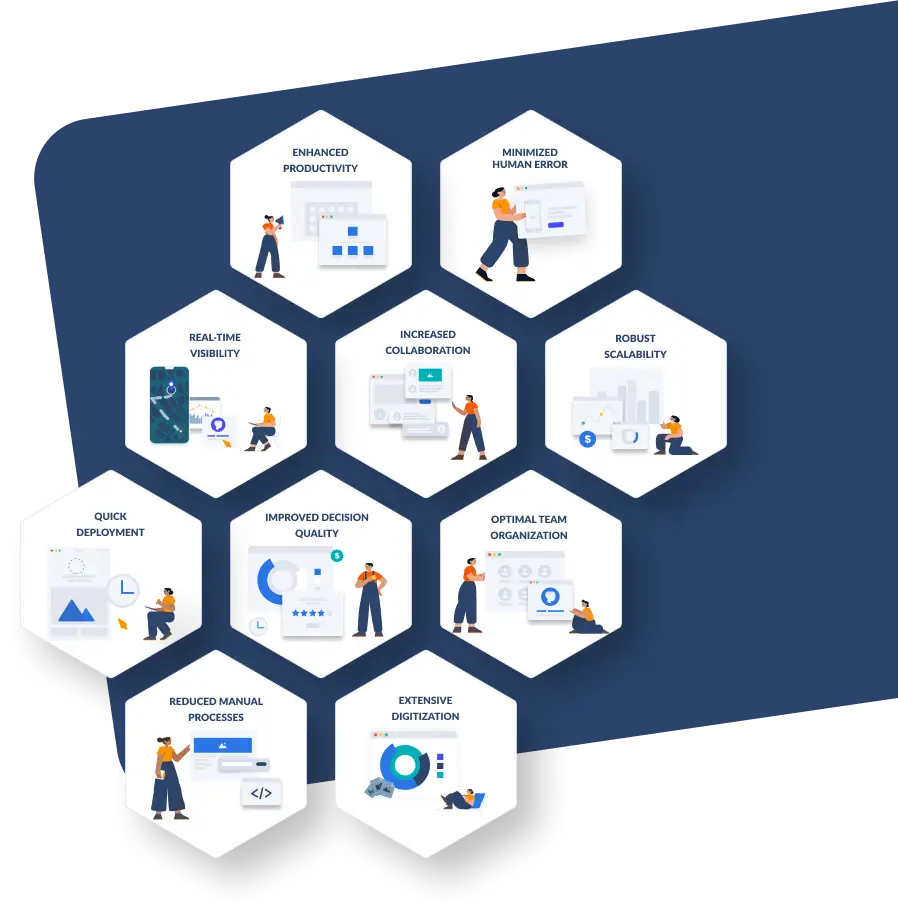What is Project Integration Management, and Why Is It Important?

Project integration management is an often overlooked knowledge area in project management methodology, which can be a mistake. Here’s why.
Project integration management is the sole overarching knowledge area for all other knowledge areas.
And as such, project integration management controls the most challenging aspect of construction work: integrating the various independent team members, tasks, processes, and strategies required to complete a successful project.
Here’s what we cover:
- What is project integration management?
- Project management vs. project integration management: what’s the difference?
- The value of project integration management:
- What are the steps in project integration management?
- What are project integration management best practices?
- The Key to Effective Project Integration Management is Project management software
- Consider a project management information system built for the construction industry
What is project integration management?
As the first project management knowledge area, project integration management provides a strategy to bring flow and synergy to the standalone and overlapping processes from all other management areas.
Project integration management has the most processes of any knowledge area and spans the entire set of process groups.
The integration management process puts project managers in control and helps them strategically plan, coordinate, and manage the many project tasks, resources, stakeholders, and deliverables required to meet their project goals.
When project stakeholders have competing objectives or scheduling conflicts, project integration management helps project managers make intelligent cost or schedule trade-offs that enable the construction team to complete the project and meet stakeholder expectations.

Project management vs. project integration management: what’s the difference?
According to the Project Management Institute (PMI), there are ten knowledge areas within project management.
- Project Integration Management
- Project Scope Management
- Project Time Management
- Project Cost Management
- Project Quality Management
- Project Resource Management
- Project Communication Management
- Project Risk Management
- Project Procurement Management
- Project Stakeholder Management
Separately, these individual project management systems contribute to the success of a project.
Project integration management combines these separate management processes into one cohesive framework.
Project integration management is the roadmap for project success.
The value of project integration management:
Project managers must manage and monitor vast amounts of materials, stakeholders, and information on a construction project. Project managers are involved in: finance, labor, scheduling, material procurement, site risks, design changes, and stakeholder scheduling, among much more.
Keeping track of project teams with many of the same concerns is incredibly challenging. But it is necessary for project success.
Project integration management allows you to deal with challenges and conflicts as they arise. In addition, integration management helps you understand how one area of your project affects another. With this, you can establish responses and prepare for changes.
Meeting challenges and managing stakeholders is only possible with a broader view of your project. That is what project integration management provides.

What are the steps in project integration management?
While deliverables and timeframes may change over time, your project’s guiding principles and direction should not. Instead, there are several steps to follow for successful project integration management.
Develop the project charter
The project charter is your first step in the planning process.
It is a high-level document that guides all your teams throughout the project life cycle and initiates the project manager’s authority to begin.
A project charter outlines broad goals and deliverables for project teams and departments. It defines the purpose of your project and acts as the “why” and not the “how” of your project.
Project charters include:
- Reason for the project
- Project objectives
- Identified risks
- General project overview
- Expected Deliverables
Create the project management plan
Your project management plan identifies “how” project teams will achieve their goals. Your project management plan should outline expectations, project scope, budget, and timeline.
Meet with key stakeholders to establish their needs and arrange procurements. Once you have established a baseline for your project, you can input information into a Gantt chart for a visual indicator of expectations.
Your project management plan should include the following:
- Project goals
- Budget expectations
- Risk management guidelines
- Workflow & Reporting guidelines
- Project scope details
- Stakeholder information
- Change management planning
While your project management plan sets out expectations, change is inevitable in construction.
Changes, miscommunication, and short-sightedness will cause cost and schedule overruns.
A management plan establishes a process with strict requirements, such as RFI use and proper communication channels.
Direct and manage project work
In this step of project integration management, you will monitor your project teams and ensure collaboration across the project life cycle.
Use a Master schedule with Work breakdown structures (WBS) to accurately track progress and for a broader outline to help contractors and subcontractors complete their tasks.
During this step, you will direct project execution and monitor resource management. Remote collaboration tools will aid communication and task tracking, especially for large-scale projects.
As each team works on project deliverables, it may be necessary to adjust timelines, materials, etc., throughout the project lifecycle. However, with proper integration management, this should not be an issue, and you should be able to adapt to changes without significant fallout.
Use your project charter as the guiding focus for your project. As a project manager, this is one of the critical focus areas throughout your project.

Project knowledge management
Another critical aspect of project integration management is controlling information and communication across the job site.
For example, complex construction projects will have numerous stakeholders and teams working side-by-side to complete various tasks. Miscommunications cause conflict, confusion, and delays.
Take advantage of project management software to unite these teams and share information through daily huddles, team meetings, toolbox talks, and safety briefings.
Share files, plan sheets, design changes, RFIs, and change orders in real-time.
An established, centralized communication channel streamlines your communication system to reduce delays.
Monitor and control project work
Project reporting is vital for construction projects. You need to assess milestones and deliverables in real-time. Use project management software to communicate and track project progress.
Using collaborative software, you can stay in touch with stakeholders, onsite teams, and key people across your project.
Early reporting allows for corrective measures to be put in place. Delays will cost affect the scope of your project and lead to project creep. Time, scope, and costs are the primary indicators you must monitor during the project life cycle.
It’s essential to make adjustments when necessary and be aware of the knock-on effects. Monitoring progress will allow you to adjust when necessary and to stay on track for your project charter.
Integrate change management and control
Integrated change control tightly organizes project change submissions from multiple stakeholders. You must direct change requests through a centralized change request process.
It may be necessary to appoint a point of contact for RFI submissions, design changes, document queries, etc. Avoid project scope creep by planning for changes. Create a robust system that can adapt when changes.
Project integration management ensures that overall project objectives stay on track when changes occur.
Project management software is the ideal solution for change management and control. Linarc is a prime example of construction management software suited for monitoring and control.
Project closeout management
As you reach the closeout phase of your project, you will face several new challenges. Contractors will be vying for time, space and attention on site, while project scope creep has likely carried over throughout the project.
Many projects phase fatigue at this stage and contractors will want to finish out projects and move on to new projects.
Contractors’ will be inclined to jump from area to area to finish out tasks, which may conflict with other trades and departments.
Both of these issues contribute to higher injuries and costly rework. Therefore, it’s essential to set the boundaries of your project scope and the expectation set for each department.
Your final tasks will be collecting and distributing all user manuals, start-up sequencing, and maintenance reviews for the final handoff to the project owner.
What are project integration management best practices?
The steps of project integration management will aid you in project success, but it’s also important to instill best practices from the outset of your project and carry them throughout.
Assemble team members early
Issue Requests for Tenders (RFT) and Requests for Quotations (RFQ) to contractors, subcontractors, and partners. Begin assembling your wider team members and establish who the relevant stakeholders are. Gain insights into projected costs concerning labor and materials and factor these into project charter and planning.
Agree on the project charter with the owner and all key stakeholders
Work with designers, planners, and contractors to establish your project charter, expected deliverables, timeframes, and budget. The project charter establishes a baseline for the project scope and expectations.
Stakeholder involvement in this stage is critical for establishing their commitment to project success.
Communicate the project management plan
Effectively communicate the project plan to all team members. Let them approach tasks through their methodologies while maintaining the expectations for their deliverables and timeline.
The project management plan is one of the core areas of successful project integration management: allowing for autonomy while maintaining alignment between overall objectives and expectations.
Establish project schedule to direct and manage work assignments
Establish your project schedule. Use a master planner to assign tasks and deliverables. Assess and correct potential scheduling conflicts before they occur and arrange material procurements during the scheduling phase for best results.
Project managers spend a great deal of time monitoring the different departments, stakeholders, and work teams involved in the project.
Project management software keeps busy project managers informed so they can take corrective action before things get out of hand.
Establish a single source of truth for all project knowledge
Have one centralized pathway for communication, information sharing, and requests. Disparate teams and communication networks will only delay projects.
Establish communication guidelines and create a streamlined system for requests and feedback. Use project management software to collect and share data, allow for effective communication, and track milestones and outputs.
Monitor, correct, and control project execution
Project integration management relies on an overarching approach to project execution. Therefore, monitoring project progress and addressing issues as they arise are vital. Proactively responding to changes, requests, and onsite issues will ensure project progresses on time and within budget.
Keep track of late-stage construction issues and close out projects for successful handover to the project owners.
Use the tools available to you
Project management software has come a long way in assisting project managers in keeping track of timelines, budgets, milestones, and communication.
Rather than using various tools to complete your project tasks, onboard all team members into one collaborative system. One designed to meet project goals, improve communication, establish effective tracking, and integrate the many dependencies of a construction site.

The Key to Effective Project Integration Management is Project management software
Project integration management is highly effective. But to achieve success, it is essential to use the right project management tools.
Project management software aligns project stakeholders’ goals and improves the project management process. Management software allows for a streamlined approach to project management and ensures collaboration across all your teams.
Linarc’s custom templates, WBS-enabled Gantt charts, resource, and task management system make this easy.
Designed to improve construction management on all fronts, Linarc has the tools you need for effective project integration management.
Consider a project management information system built for the construction industry
Successful construction professionals stay on top of every aspect of their projects, from initiation through closeout.
Construction project management software streamlines these complex processes, manages task-based workflows, and allows seamless communication for successful project completion.
Get a custom demonstration of the Linarc project management system today—the intelligent, intuitive, easy-to-use tool for managing the complexity of today’s building projects.
Connect – Build – Thrive with Linarc




